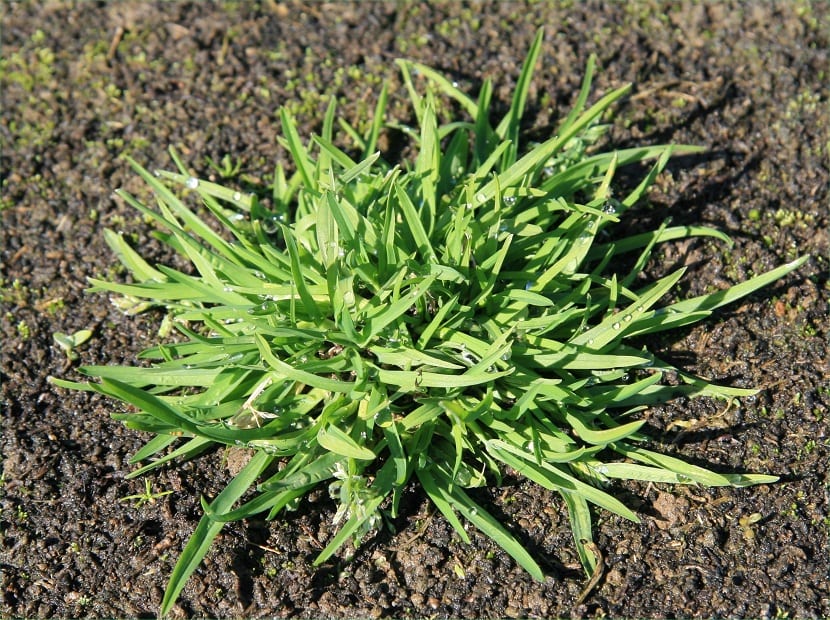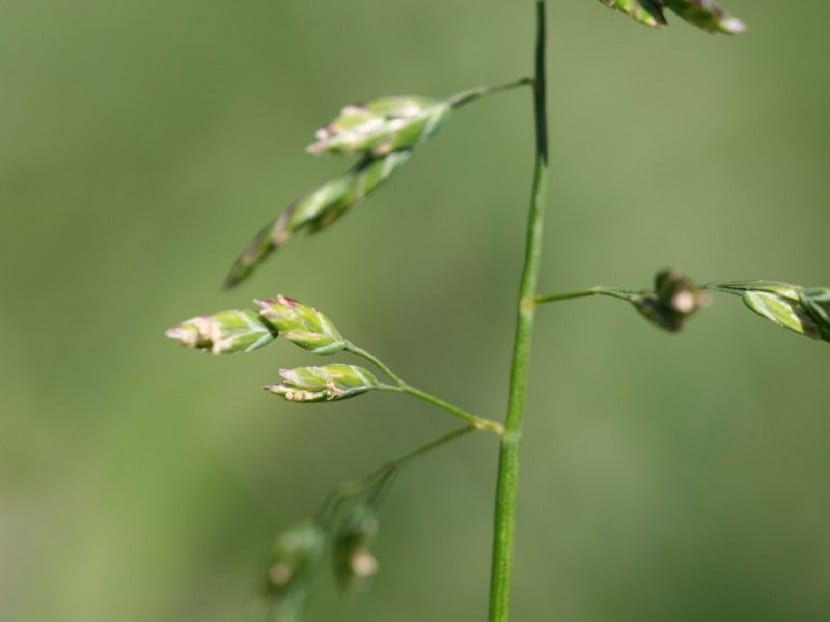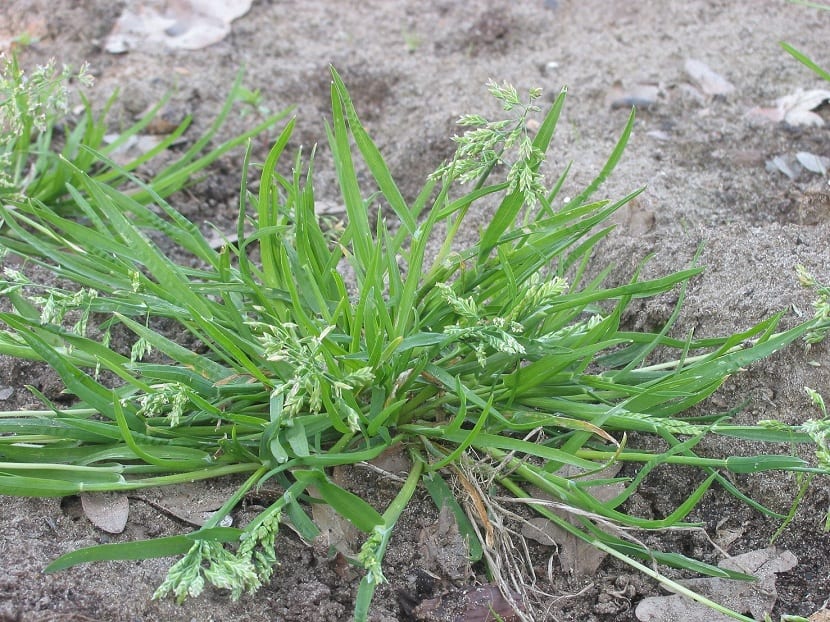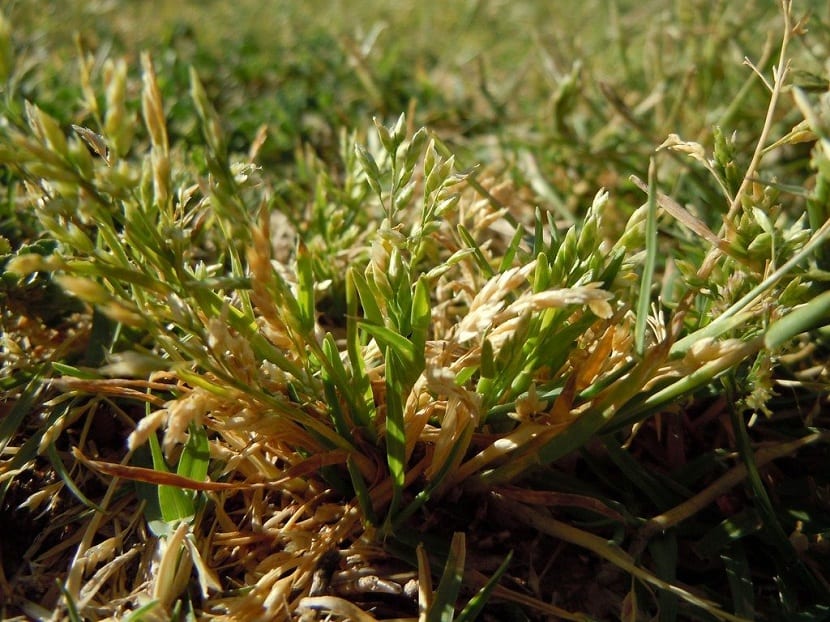
There are some people who go for a greener lawn for their garden. Ecological lawns are those that grow on their own and do not need chemicals or fertilizers to be able to grow in conditions or stay healthy. Today we are talking about a perfect species for this that we are looking for. It's about the Creeping bluegrass. It is the name given to this plant belonging to the Poaceae family and it is known by other common names such as winter grass, pelosa, annual poa, spikelets and rhizá feather, among others.
If you want to have an ecological lawn in your garden, in this post we are going to explain the main characteristics of the Creeping bluegrass, as well as their care and requirements.
Key features

It is a plant native to Europe, America, Asia, Oceania and Africa. As you can see, it is found all over the world. It is capable of reaching 30 centimeters in height if we let it grow in conditions and about 20 cm in width. To pollinate its flowers, it uses anemophilia and cleistogamy. This is how you can pollinate your hermaphrodite-type flowers.
One of the advantages that you will obtain by having it in your garden is that attracts wildlife. This means that other insects can come to pollinate the plants in your garden and it can fill with life. Sometimes and depending on how you use the garden, it can be somewhat annoying. If you have a lot of density of plants in the garden and you are in the hot season and having a picnic with the family, probably, so many insects in between will end up being an unpleasant experience. However, it is a good advantage for the appearance and health of the garden.
Another of its peculiar characteristics is that it is capable of forming a fairly dense tapestry and, thanks to this, spreading over the land with the stolons it has. Its reproductive capacity is high. This is because, although very low cuts of the grass are made, they are capable of reproducing the seed. Thus, it will be able to expand every year and supplant those most degraded parts. It will also fill in the gaps in the garden that can inevitably form.
It is a very light green color. This makes the garden look hotter colored patches that make a good contrast to the tussock-type grasses. Its ability to reproduce seeds despite very low cuts makes it highly invasive.
Needs of the Creeping bluegrass

The seasonality of this plant causes that in summer it dies after reproducing the seeds. This it will cause us the existence of some holes in the lawn. Sometimes mutations of this plant occur that give it a biannual character and even more.
This species grows best in soils with an acidic, neutral or alkaline pH. The type of soil is indifferent to him. What it does need is that the underground part can grow in a soil whose texture is sandy and loamy. In a clay texture it would need more moisture.
With this information we can adapt the irrigation to what is necessary. We want to maintain some constant humidity in the soil and more if the lawn is going to have sun exposure. This makes us want this humidity so that watering is not excessive because, as we will see later, it can be harmful to the plant. The garden area must have good drainage as it does not tolerate puddles. Something very common that happens when we have Poa annua is to treat it like any other grass. On the contrary, being a completely ecological lawn, this plant is fully adapted to less watering. We only have to maintain the necessary humidity, so the indicator that we have to water again is that we see that the soil is drying out.
It is quite demanding in terms of lighting needs. It prefers to be in full sun rather than in the shade. In this way, the necessary nutrients are guaranteed so that it can grow correctly. However, if part of the garden is also shady, do not worry because it will not have many problems growing.
Profit Share

As for its resistance, it is capable of withstanding some occasional frosts in winter and high temperatures in summer. Yes indeed, If the environment is very dry, the frequency of irrigation will have to be increased a little more.
Among its utilities we find the formation and maintenance of green roofs. We have already mentioned the ecological lawn. However, there are also other uses such as being placed on green roofs, in degraded places for restoration and even in areas of intense shade where other lawns do not survive well.
The capacity of these plants to survive and expand is enormous, so they will not give too many problems even if we give them other more complex utilities. A curious fact is that it is capable of surviving and reproducing seeds even if the mowing is of one centimeter. At a single centimeter it is capable of continuing to reproduce. As we have seen in other species such as the Red fescue, the height of the mowing would have to remain between 3 and 5 centimeters to guarantee its health. In this case, we can have very short grass that will not cause problems.
It is capable of producing between 75.000 and 225.000 ears per year per square meter. These seeds can be dormant in a field for a couple of years. They will not germinate until the condition for it is suitable. Therefore, being a plant with a high survival rate, it does not need fertilizer or other chemicals to look good on a lawn.
In its life cycle we find that it is a winter plant, which means that its life cycle ends before summer begins. Its germination takes place in autumn and develops very quickly. All the energy resources of the plant are put into the seed for its rapid growth.
As you can see, a good option for ecological grass would be the Poa annua.